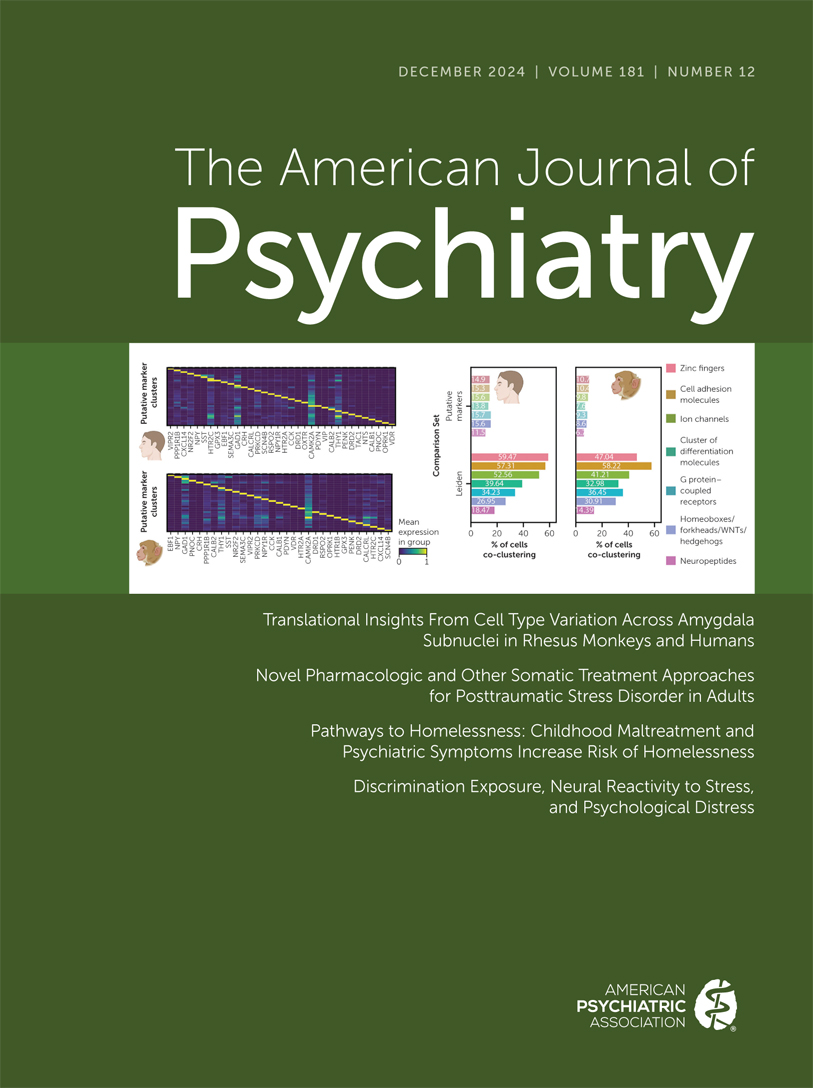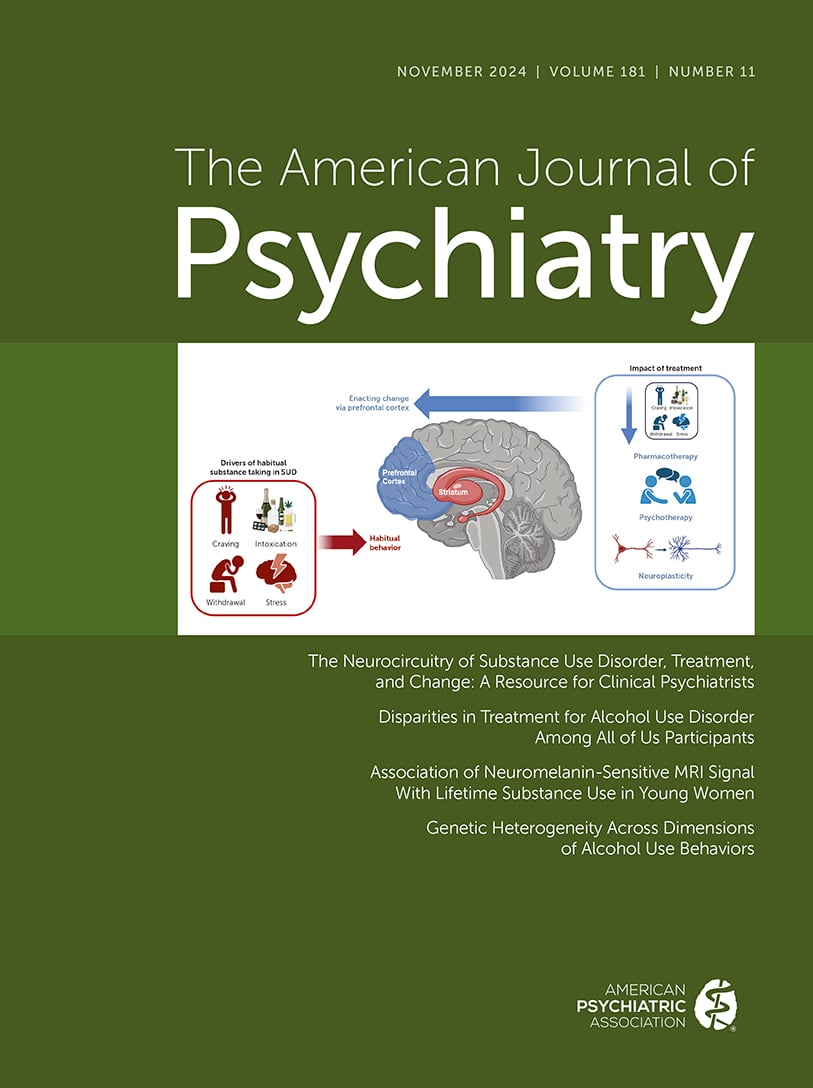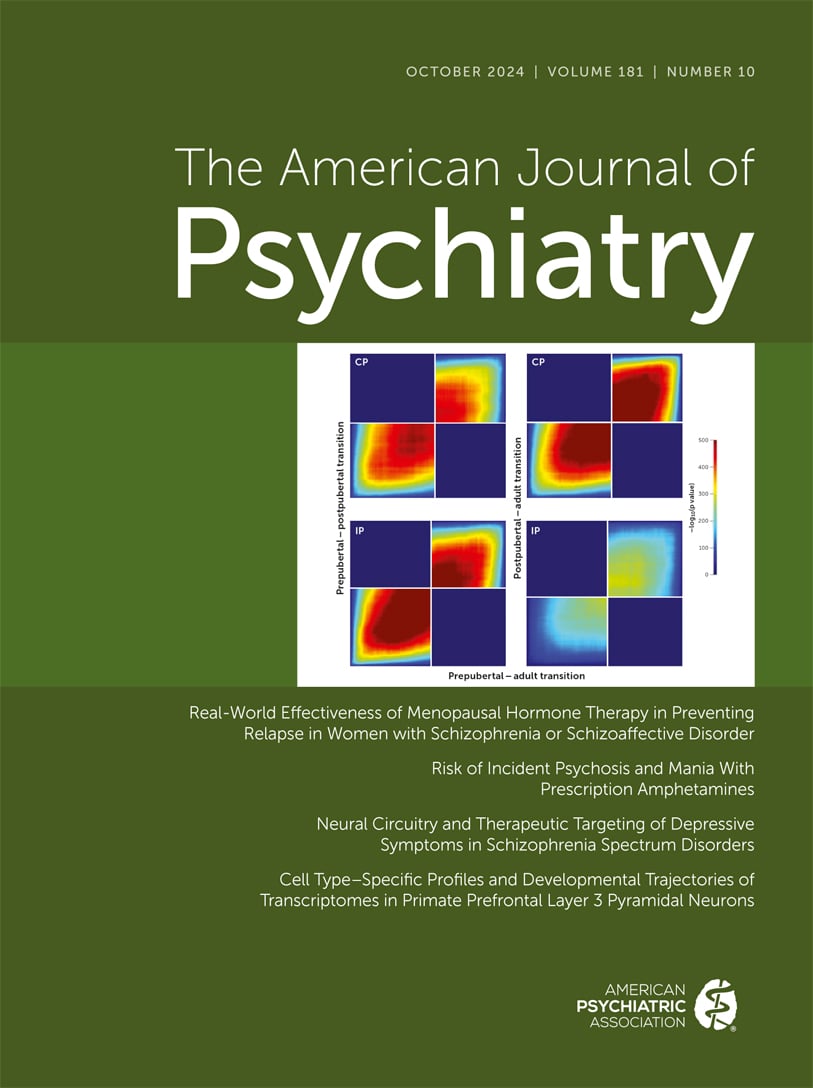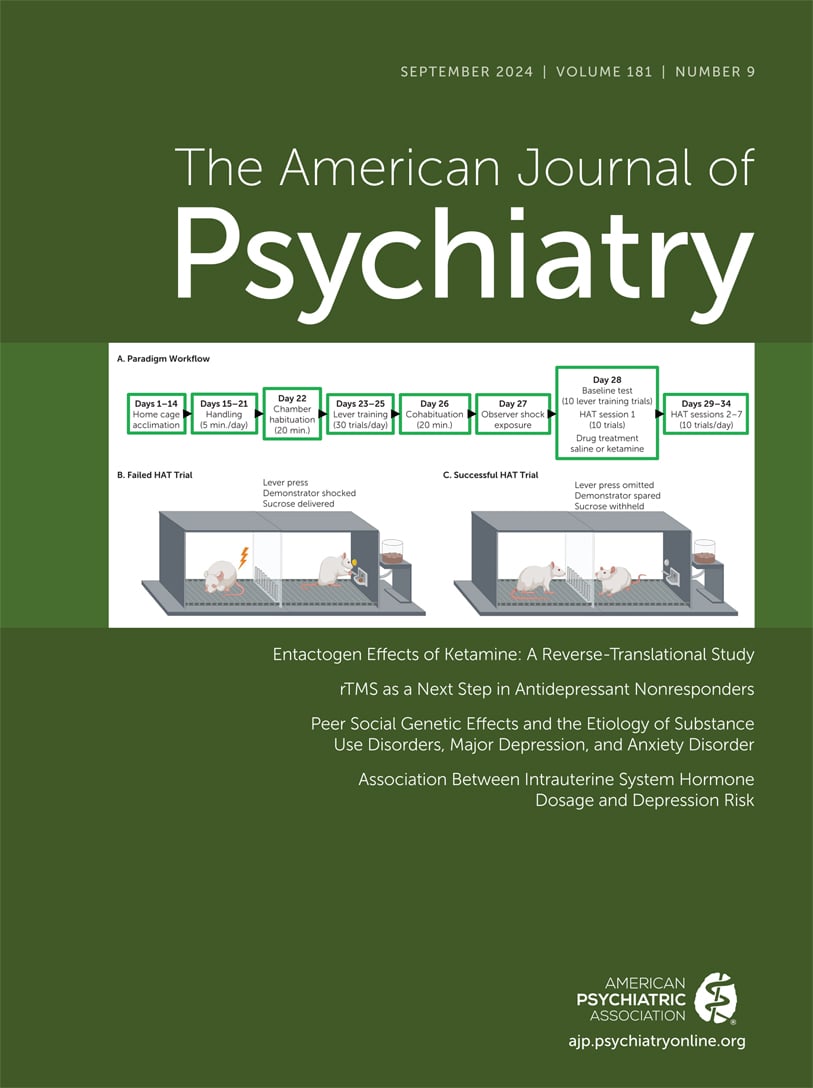American Journal of Psychiatry
- Volume 160
- Number 4
- April 2003
Editorial
Commemorations
Reviews and Overviews
Publication date: 01 April 2003
Pages636–645Endophenotypes, measurable components unseen by the unaided eye along the pathway between disease and distal genotype, have emerged as an important concept in the study of complex neuropsychiatric diseases. An endophenotype may be neurophysiological, ...
https://doi.org/10.1176/appi.ajp.160.4.636Publication date: 01 April 2003
Pages646–656The elucidation of the human genome presents a challenge for psychiatry—determining the impact of thousands of genes on brain functions relevant to mental disorders. For both historical and practical reasons, the mouse has become the mammal of choice for ...
https://doi.org/10.1176/appi.ajp.160.4.646Publication date: 01 April 2003
Pages657–666OBJECTIVE: An international effort is in progress to discover candidate genes and pathways associated with psychiatric disorders, including two of the most serious diseases, schizophrenia and mood disorders, through the use of new technology—microarrays. ...
https://doi.org/10.1176/appi.ajp.160.4.657Clinical Case Conference
Images in Psychiatry
Article
Publication date: 01 April 2003
Pages671–676OBJECTIVE: Studies have shown that genetic factors are significant in predisposing individuals to shyness and social phobia. Toward further elucidating the genetic structure of shyness, the authors examined four functional polymorphisms that make ...
https://doi.org/10.1176/appi.ajp.160.4.671Publication date: 01 April 2003
Pages677–679OBJECTIVE: Weight gain, leading to further morbidity and poor treatment adherence, is a common consequence of treatment with antipsychotic drugs. A recent study showed that a polymorphism of the promoter region of the serotonin 5-HT2C receptor gene is ...
https://doi.org/10.1176/appi.ajp.160.4.677Publication date: 01 April 2003
Pages680–686OBJECTIVE: Linkage studies of bipolar disorder and schizophrenia have found overlapping evidence for susceptibility genes in four chromosomal regions—10p12-14, 13q32, 18p11.2, and 22q12-13. The authors previously demonstrated familial clustering of ...
https://doi.org/10.1176/appi.ajp.160.4.680Publication date: 01 April 2003
Pages687–695OBJECTIVE: Data on use and misuse of six classes of illicit substances by male twin pairs were used to examine whether genetic and shared environmental risk factors for substance use disorders are substance-specific or -nonspecific in their effect. METHOD:...
https://doi.org/10.1176/appi.ajp.160.4.687Publication date: 01 April 2003
Pages696–702OBJECTIVE: Disturbance of smooth pursuit eye movements has been discussed as marking a putative endophenotype closely associated with the genetic basis of schizophrenia. Previous studies are not conclusive in regard to the specificity of this marker. ...
https://doi.org/10.1176/appi.ajp.160.4.696Publication date: 01 April 2003
Pages703–708OBJECTIVE: There is a substantial genetic contribution to schizophrenia but no way to readily identify individuals at risk. Biological abnormalities reflecting greater genetic vulnerability may be discovered by examining healthy family members of patients ...
https://doi.org/10.1176/appi.ajp.160.4.703Publication date: 01 April 2003
Pages709–719OBJECTIVE: The identification of neurobiological intermediate phenotypes may hasten the search for susceptibility genes in complex psychiatric disorders such as schizophrenia. Earlier family studies have suggested that deficits in executive cognition and ...
https://doi.org/10.1176/appi.ajp.160.4.709Publication date: 01 April 2003
Pages720–726OBJECTIVE: Motivated by the public health importance of major depression and calls to study the effectiveness of treatments frequently used in routine practice, the authors characterized the usual outpatient care of acute-phase major depression in a ...
https://doi.org/10.1176/appi.ajp.160.4.720Publication date: 01 April 2003
Pages727–733OBJECTIVE: This observational study examined the effectiveness of somatic antidepressant treatments as administered in the community. METHOD: The study group consisted of 285 subjects with an intake diagnosis of major depressive disorder who had entered ...
https://doi.org/10.1176/appi.ajp.160.4.727Publication date: 01 April 2003
Pages734–740OBJECTIVE: Although the newer antidepressants are widely used, little is known about how long it takes to see their full effect. The authors sought to determine how many weeks a fluoxetine trial with no improvement should continue before treatment is ...
https://doi.org/10.1176/appi.ajp.160.4.734Publication date: 01 April 2003
Pages741–748OBJECTIVE: The study evaluated the efficacy and tolerability of ziprasidone, compared with placebo, in the treatment of adult patients with acute bipolar mania. METHOD: Patients with a primary DSM-IV diagnosis of bipolar I disorder and a current manic or ...
https://doi.org/10.1176/appi.ajp.160.4.741Publication date: 01 April 2003
Pages749–756OBJECTIVE: This study assessed the efficacy of two fixed doses of paroxetine in the treatment of generalized anxiety disorder. METHOD: Outpatients (N=566) with generalized anxiety disorder and no other axis I disorder were eligible if they scored ≥20 on ...
https://doi.org/10.1176/appi.ajp.160.4.749Publication date: 01 April 2003
Pages757–764OBJECTIVE: The study examined trends in use of inpatient and outpatient mental health services, including pharmacotherapy, among privately insured children and adolescents from 1997 to 2000. METHOD: Data from a national database of more than 1.7 million ...
https://doi.org/10.1176/appi.ajp.160.4.757Publication date: 01 April 2003
Pages765–772OBJECTIVE: Suicide risk was addressed in relation to the joint effect of factors regarding family structure, socioeconomics, demographics, mental illness, and family history of suicide and mental illness, as well as gender differences in risk factors. ...
https://doi.org/10.1176/appi.ajp.160.4.765Publication date: 01 April 2003
Pages773–779OBJECTIVE: Cigarette smoking is associated with a higher risk for suicide and attempted suicide, but psychopathological or biological explanations for this association have not been explored. Lower serotonin function and impulsive/aggressive traits are ...
https://doi.org/10.1176/appi.ajp.160.4.773Brief Report
Publication date: 01 April 2003
Pages780–783OBJECTIVE: This study examined the prevalence of psychiatric symptoms among residents/workers in Manhattan 3–6 months after the Sept. 11, 2001, terrorist attacks. METHOD: A total of 1,009 adults (516 men and 493 women) were interviewed in person ...
https://doi.org/10.1176/appi.ajp.160.4.780Publication date: 01 April 2003
Pages783–785OBJECTIVE: In a group of crime victims, the authors investigated overlap between acute stress disorder and posttraumatic stress disorder (PTSD) diagnoses and their relative ability to predict PTSD at 6 months. METHOD: A mixed-sex group of 157 victims of ...
https://doi.org/10.1176/appi.ajp.160.4.783Publication date: 01 April 2003
Pages785–787OBJECTIVE: The authors investigated whether narrow definitions of unexplained fatigue syndromes that require additional minor somatic symptoms are more strongly associated with psychiatric morbidity than wider ones. METHOD: This was a secondary analysis ...
https://doi.org/10.1176/appi.ajp.160.4.785Publication date: 01 April 2003
Pages788–790OBJECTIVE: This study examined the effectiveness of a single session of earthquake simulator-assisted exposure treatment of traumatic stress in earthquake survivors. METHOD: Ten earthquake survivors in Turkey were given one session of exposure to ...
https://doi.org/10.1176/ajp.160.4.788Publication date: 01 April 2003
Pages790–792OBJECTIVE: Previous reports suggesting that selective serotonin reuptake inhibitor (SSRI) use is associated with increased suicidal risk have not assessed completed suicides. The authors analyzed reports from randomized controlled trials to compare ...
https://doi.org/10.1176/appi.ajp.160.4.790Publication date: 01 April 2003
Pages793–795OBJECTIVE: Aside from diminished daily functional capacity, individuals with depression are at greatly higher risk of suicide. Given that both endogenous depression severity and the incidence of suicide peak during the spring and summer months, it would ...
https://doi.org/10.1176/appi.ajp.160.4.793Letter to the Editor
Book Forum: Genetics
Book Forum: Neuropsychiatry
Book Forum: Child and Adolescent Psychiatry
Book Forum: Schizophrenia
Book Forum: Obsessive-Compulsive Disorder
Corrections
Past Issues
View Issues Archive
Vol. 181 | No. 12

Vol. 181 | No. 11

Vol. 181 | No. 10
